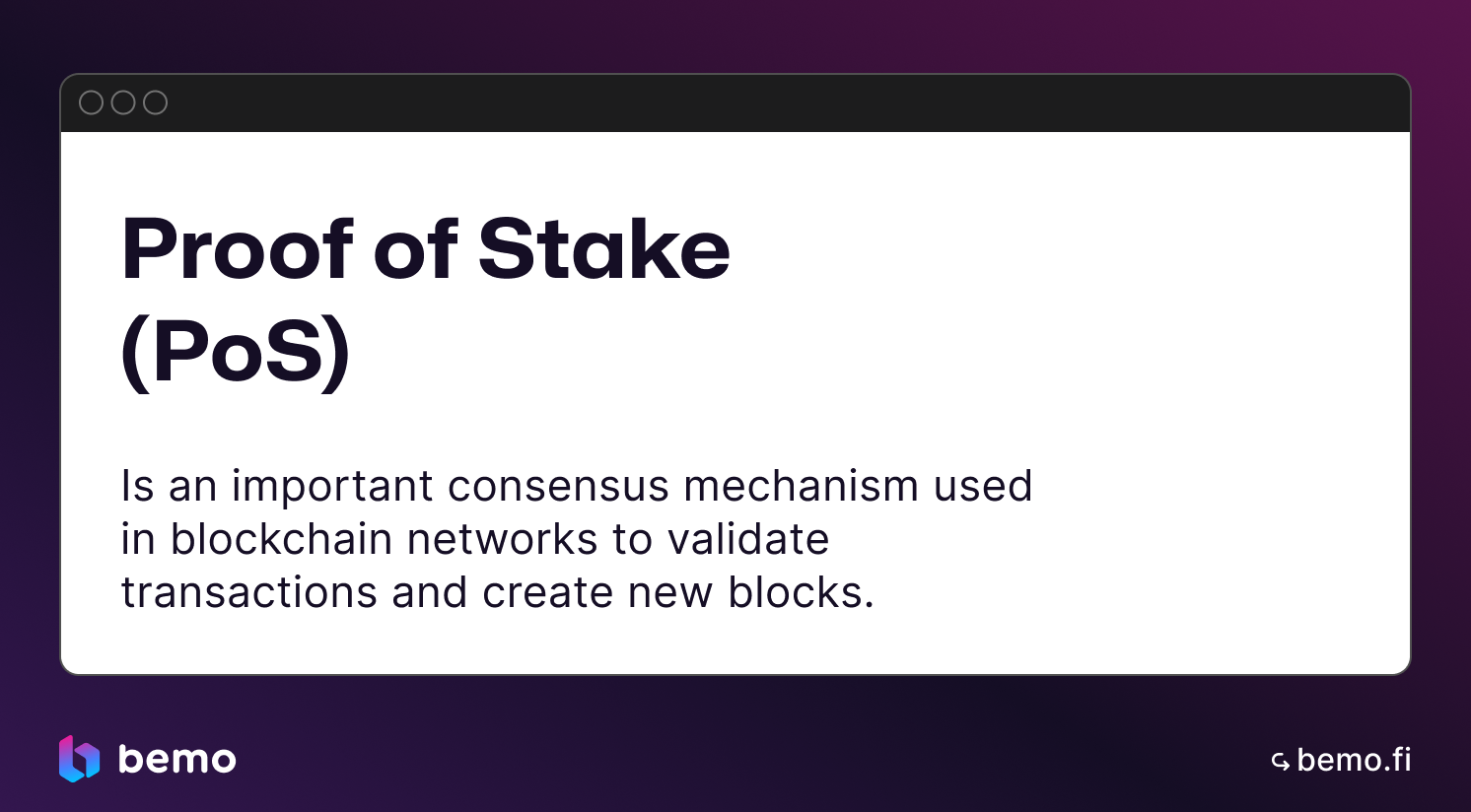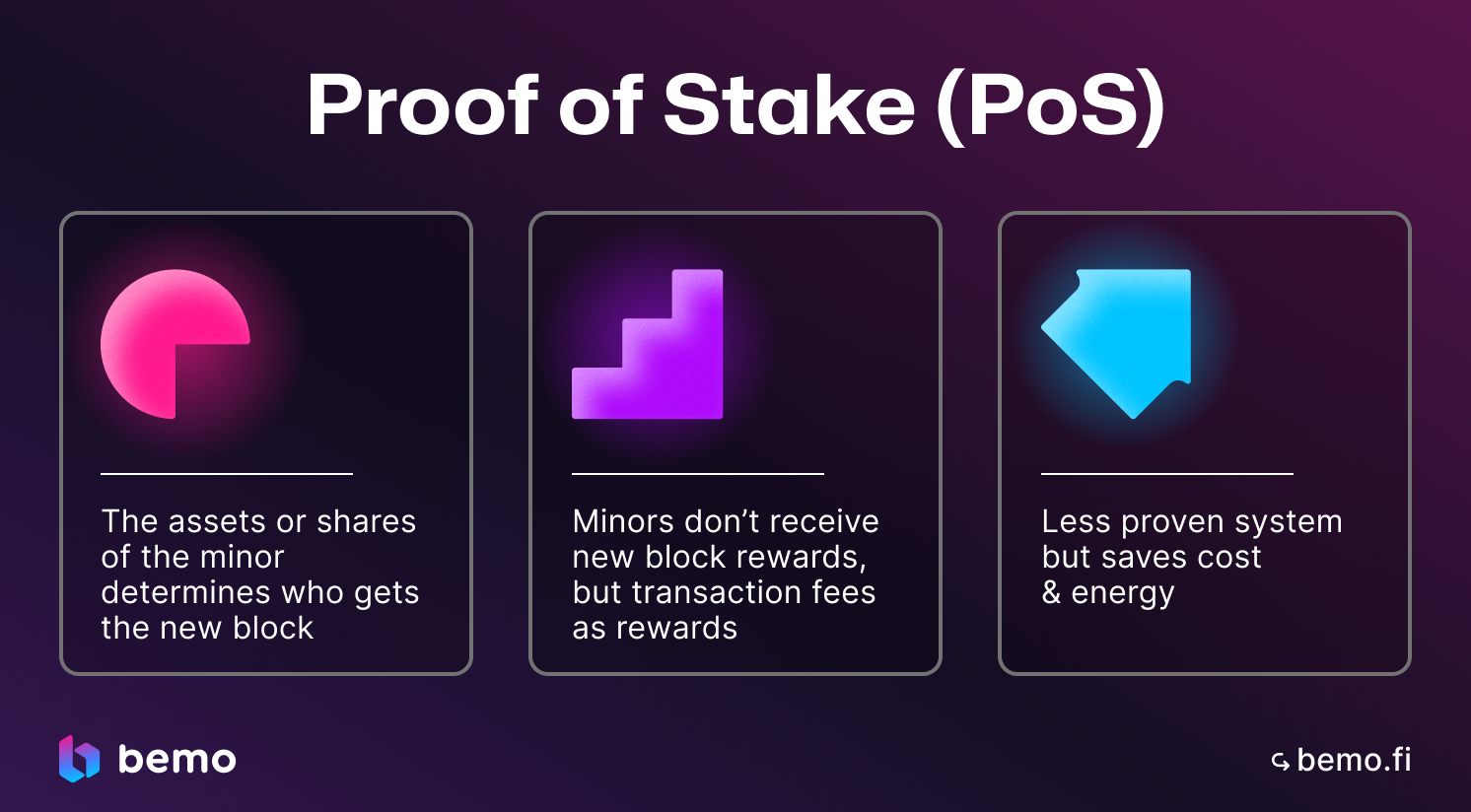
Proof of Stake (PoS) is an important consensus mechanism used in blockchain networks to validate transactions and create new blocks. Unlike Proof of Work (PoW), which relies on computational power, PoS uses a validator's stake in the network—the amount of cryptocurrency they hold — to secure the blockchain. This method significantly reduces energy consumption and enhances scalability, making it an increasingly popular choice for modern blockchains.
In this article, we will try to understand the importance of proof of stake for crypto and make a short guide for our education.
Understanding Proof of Stake
As we said at the beginning, Proof of Stake is a fundamental concept for consensus that validates blockchain and network performance.If simplified, bigger stake – more stable chain. In the proof of stake algorithm, stakers become node validators and receive transaction fees as a reward for staking. Here are the key parts of the Proof-of-Stake blockchain:
PoS Nodes
Nodes in a Proof of Stake network are the computers or devices that participate in validating transactions and maintaining the blockchain. Each node can act as a validator if it meets the network’s staking requirements. Validators are selected based on the size and duration of their stake, ensuring a fair and decentralized process.
PoS Staking
Staking involves locking a certain amount of cryptocurrency in a wallet to participate in the validation process. The larger the stake, the higher the chances of being chosen as a validator. Stakers earn rewards for their participation, often in the form of additional cryptocurrency.
PoS Validators
Validators are responsible for proposing and verifying new blocks on the blockchain. They ensure the accuracy of transactions and prevent fraudulent activities. If a validator acts dishonestly, they risk losing a portion of their staked assets — a process known as slashing.
PoS Security
Proof of Stake enhances security by making attacks costly. To compromise the network, an attacker would need to own a majority of the cryptocurrency in circulation, which is often financially unfeasible. Additionally, slashing mechanisms deter malicious behavior by penalizing dishonest validators.
Benefits of Proof of Stake:
- Energy Efficiency: PoS consumes significantly less energy compared to PoW, as it doesn’t require extensive computational power.
- Scalability: PoS networks can handle more transactions per second, making them suitable for large-scale applications.
- Decentralization: By eliminating the need for expensive mining equipment, PoS makes blockchain participation accessible to a broader audience.
- Enhanced Security: Staking reduces the risk of attacks by aligning validators’ incentives with the network’s success.
How Proof of Stake Works

In a PoS system:
- Validators lock their cryptocurrency as a stake.
- The network randomly selects a validator based on the size of their stake.
- The chosen validator proposes a new block and validates transactions.
- Other validators verify the block’s accuracy.
- Once the block is validated, it’s added to the blockchain, and the validator receives a reward.
This process ensures consensus in the network while maintaining efficiency and security.
Proof of Stake vs. Proof of Work
Examples of PoS Cryptocurrencies
- Ethereum (ETH): Transitioned to PoS in 2022 with Ethereum 2.0, enhancing scalability and energy efficiency.
- Cardano (ADA): Operates on the Ouroboros PoS protocol, prioritizing security and sustainability.
- Polkadot (DOT): Uses a nominated PoS model to facilitate interoperability between blockchains.
- Tezos (XTZ): Allows flexible governance and rewards participants for staking.
- Toncoin (TON): TON’s design focuses on scalability, speed, and environmental sustainability, making PoS a natural fit
How to Make Money with PoS
Earning rewards through Proof of Stake is straightforward. And we can list a couple of ways to earn rewards by proof-of-stake algorithms.
Staking in Wallet
Some non-custodial wallets have staking functions straight into the wallet. Hold and lock your PoS coins in a compatible wallet. Earn staking rewards for helping secure the network.
Delegating to a Validator

Validators or stakers lock their cryptocurrency and participate in securing the network. Delegate your tokens to trusted validators who handle the staking process. Rewards are distributed based on the amount staked and the validator’s performance.
Staking on Crypto Exchanges
Many cryptocurrency exchanges, such as Binance, Coinbase, and Kraken, offer staking services. Users can deposit their cryptocurrency into staking pools and earn rewards without running a validator node. This is an easy entry point for beginners.
Liquid Staking Protocols
Blockchains such as TON or ETH have high entry thresholds (32 ETH and 10000 TON or $86400 and $40000 accordingly) and liquid staking protocols such a Lido for ETH or bemo.fi for TON allow you to stake any amount of tokens and earn validator rewards.
Risks of Proof of Stake
Slashing
Validators who act dishonestly or fail to perform their duties can lose a portion of their staked assets. This penalty ensures network integrity but poses a financial risk to validators. What type of failure? For example – fraudulent transactions or going offline
Centralization Risks
Large holders of cryptocurrency have a higher chance of being selected as validators, which could lead to centralization. It reduces decentralization and potentially compromises the fairness of the system. To mitigate this, some PoS networks implement mechanisms to limit the influence of large stakes.
Network Attacks: Although rare, a 51% attack is possible if a single entity controls the majority of the staked assets.
Economic Inequality: PoS favors those with larger stakes, as higher stakes increase the likelihood of being selected as a validator, creating a wealth concentration over time. In that case, good governance can help to fix this issue.
Liquidity Constraints: Staked tokens are often locked for a specific period, making them unavailable for trading or other uses. That problem served to create liquid staking protocols as bemo.
Validator Dependency: Delegators rely on validators to act honestly; if the validator misbehaves or is slashed, delegators can lose funds.
Smart Contract Vulnerabilities: In liquid staking or DeFi integrations, staking derivatives may introduce risks related to bugs or exploits in smart contracts.
Inflation Dilution: Rewards issued to stakers can cause inflation, diluting the value of tokens held by non-staking participants.
PoS offers significant advantages, but understanding these risks is crucial for informed participation.
Proof of Stake FAQs
What Are the Risks of PoS?
The primary risks include slashing for dishonest behavior, potential centralization, and market volatility that could affect the value of staked assets.
How Do I Stake My Cryptocurrency?
You can stake cryptocurrency through wallets, staking pools, or exchanges. Choose a method that aligns with your technical expertise and risk tolerance.
What Is the Future of PoS?
As blockchain technology evolves, PoS is expected to play a significant role due to its efficiency and scalability. More networks are likely to adopt PoS or hybrid consensus models.
The Bottom Line
Proof of Stake is a transformative consensus mechanism that addresses many limitations of Proof of Work. Its energy efficiency, scalability, and accessibility make it a cornerstone of modern blockchain systems. By understanding its workings, benefits, and risks, users can make informed decisions about participating in PoS networks and contributing to the blockchain revolution.








